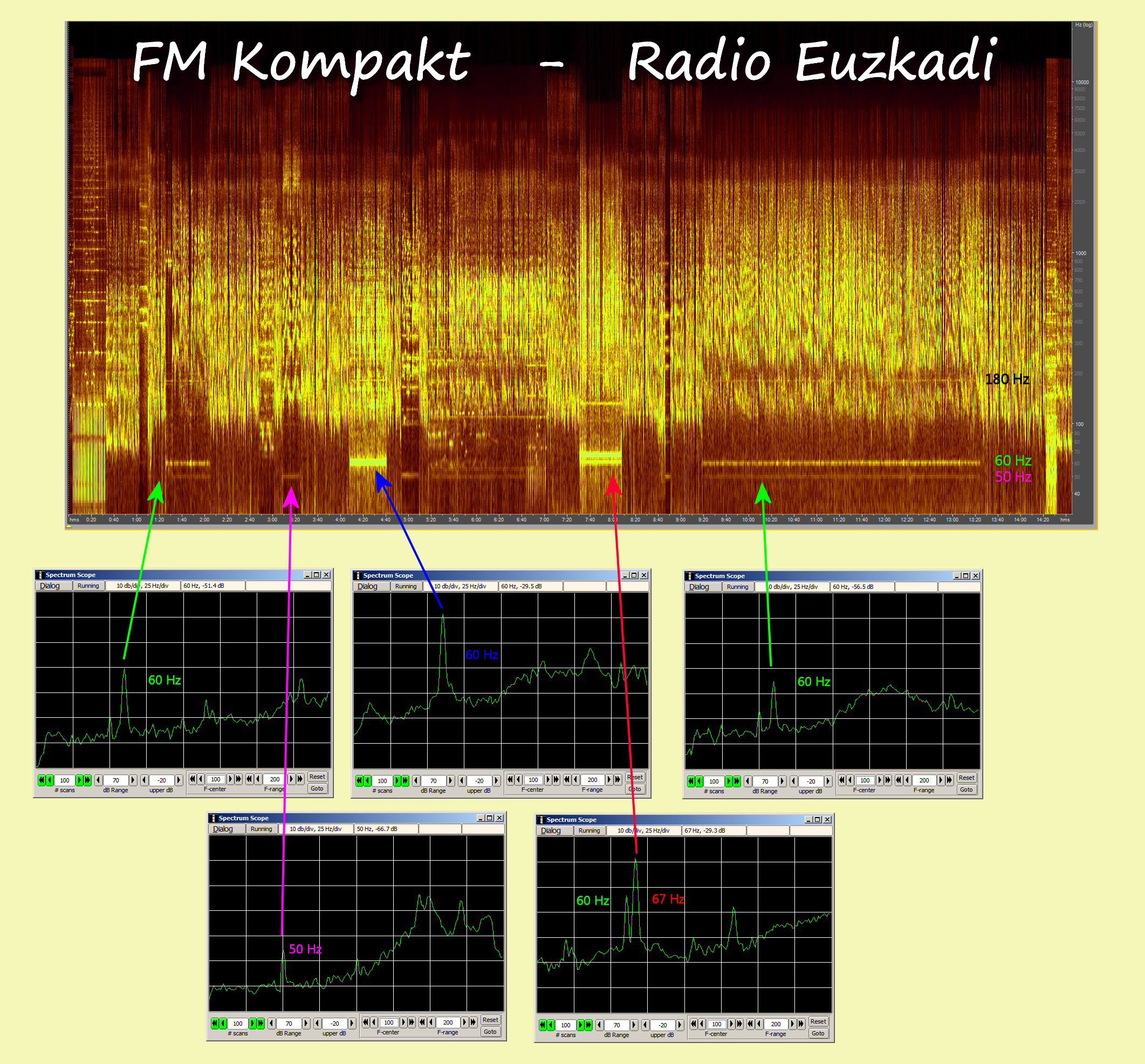http://www.rhci-online.net/radiogram/radiogram.htm
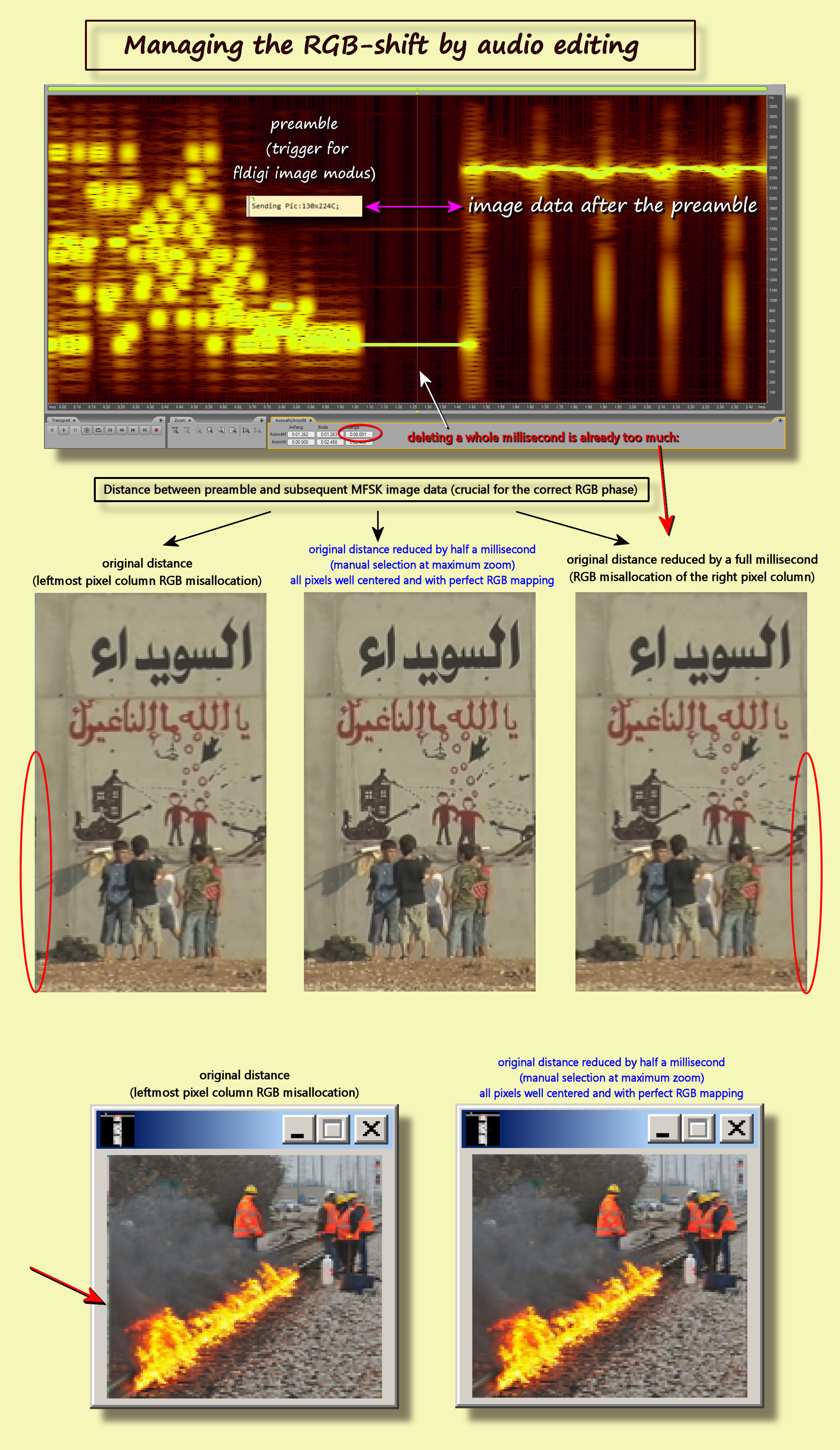
RSID: <<2019-02-
http://www.rhci-online.net/radiogram/radiogram.htm

RSID: <<2019-02-
02T13:30Z MFSK-64 @ 11600000+1500>>
In Chicago, in has been so cold that railroad tracks are set on
fire to allow repairs ...
Sending Pic:130x115C;
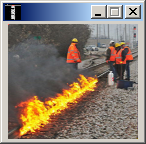
Fire is also used at switches.
From
bit.ly/2SejZhC
Please report decode to
themightykbc@gmail.com
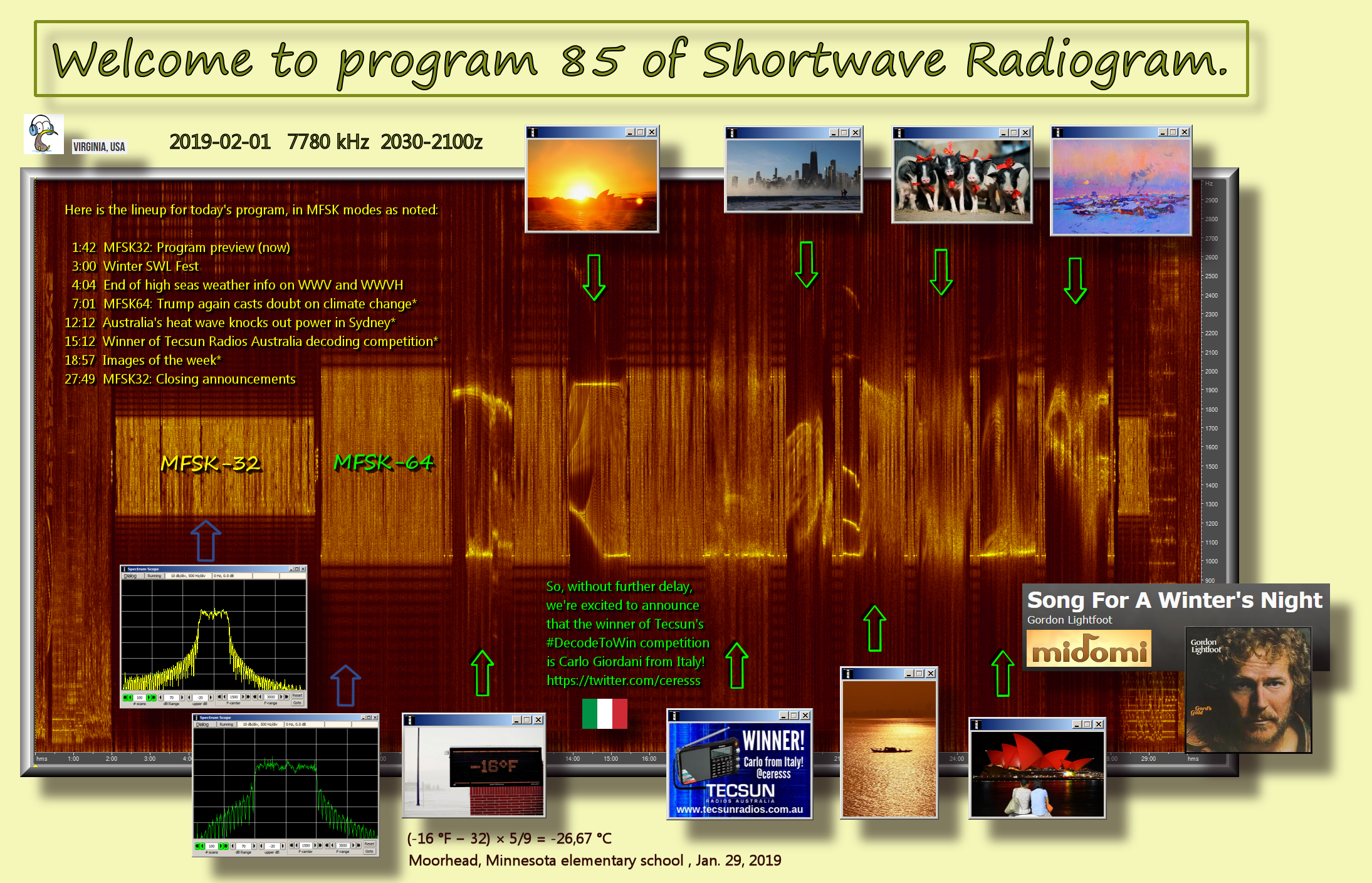
RSID: <<2019-02-01T
20:31Z MFSK-32 @ 7780000+1500>>
WINTER SWL FEST
28 February-2 March 2019
Plymouth Meeting (near Philadelphia), Pennsylvania
The Winter SWL Fest is a conference of radio hobbyists of all
stripes, from DC to daylight. Every year scores of hobbyists
descend on the Philadelphia, Pennsylvania suburbs for a weekend
of camaraderie. The Fest is sponsored by NASWA, the North
American Shortwave Association, but it covers much more than just
shortwave; mediumwave (AM), scanning, satellite TV, and pirate
broadcasting are among the other topics that the Fest covers.
I plan to attend and hope to see you there.
Information: http://www.swlfest.com
From ARRL.org:
National Weather Service Dropping High Seas and Storm Warnings on
WWV/WWVH
30 January 2019
The National Weather Service (NWS) is discontinuing its high seas
and storm warnings transmitted via National Institute of Science
and Technology (NIST) WWV/WWVH time and frequency-standard HF
transmissions, starting January 31 at 1800 UTC. The NWS warnings
are aimed at the Atlantic, the Gulf of Mexico, and the Pacific.
"This service is being terminated because weather information in
the current broadcast format does not support frequent-enough
updates for changes in marine weather and cannot provide enough
detail in the allotted window required by mariners to avoid
hazardous weather," NWS said in announcing the discontinuation.
"Additionally, alternative technologies and numerous media
outlets that provide weather information in various formats have
overtaken the need for providing weather information through the
NIST frequency signals."
The NWS said other sources of marine weather information, high
seas alerts, and detailed forecasts are available over satellite,
telephone, the internet, marine fax, radio fax, and VHF radio.
The NWS, US Coast Guard, and US Navy provide multiple
dissemination methods for storm positioning, high sea areas,
observations, forecasts, outlooks, and warnings for both coastal
and oceanic marine zones near the US, all through a variety of
technologies, including NAVTEX and the Global Maritime Distress
and Safety System (GMDSS).
http://www.arrl.org/news/national-weather-service-dropping-high-seas-and-storm-warnings-on-wwv-wwvh
Kim: WWV in Colorado transmits on 2500, 5000, 10000, 15000,
20000, and 25000 kHz. WWVH in Hawaii transmits on 2500, 5000,
10000, and 15000 kHz.
Shortwave Radiogram now changes to MFSK64 ...
RSID: <<2019-02-01T20:37Z MFSK-64 @ 7780000+1500>>
This is Shortwave Radiogram in MFSK64
Please send your reception report to
radiogram@verizon.net
From Voice of America:
As Arctic Chill Hits US, Trump Again Casts Doubt on Climate
Change
Steve Herman, W7VOA
WHITE HOUSE - A Tuesday tweet from a U.S. government scientific
agency seems relatively innocuous: "Winter storms do not prove
global warming is not happening."
The message from the National Oceanic and Atmospheric
Administration (NOAA), which is devoted to climate science and
information, includes a link citing research that severe
snowstorms may be even more likely in a warming global climate
because higher ocean temperatures appear to create more moisture.
Many are viewing Tuesday's post as a rebuttal to President
Trump's tweet late Monday noting an approaching deep freeze for
the American Midwest and asking "What the hell is going on with
Global Waming (sic). Please come back fast, we need you."
A polar vortex has returned this week to the Midwest bringing
extremely low temperatures that could break records.
NOAA denies any connection between the president's comment and
its social media posting.
"We routinely put this story out at these times," the agency said
in a statement. "Our scientists weren't responding to a tweet."
Most scientists say there is little valid research to counter the
prevailing view climate change is real and note research also
demonstrates that with global warming there will be more
frequently extreme temperatures at both ends of the thermometer.
With a forecast of icy roads around the nation's capital, one
item of unanimous consent throughout the Trump administration
Tuesday is non-emergency federal workers – just two days back on
the job after a record-long shutdown – could leave early because
of the weather.
"Employees of Federal offices in the Washington, D.C., area are
authorized for early departure," according to a notice from the
U.S. Office of Personnel Management. "Employees should depart 2
hours earlier than their normal departure times and may request
unscheduled leave to depart prior to their staggered departure
times."
The notification is intended, in part, to alleviate congestion on
streets that could soon become hazardous.
The ability of a mere dusting of snow or sheets of ice on
roadways and sidewalks to create pandemonium in the U.S. center
of power frequently puzzles those who have migrated to this part
of the country from harsher winter climates.
A January 2016 snowstorm paralyzed the region, although only 2.5
centimeters of snow fell on Washington, D.C. roadways. There were
hundreds of traffic accidents and many motorists abandoned their
vehicles on highways after untreated roads became impassible with
black ice.
The mess and lack of preparedness prompted a public apology by
the mayor of Washington, D.C.
Muriel Bowser was taking no such chances on Tuesday, three years
after the so-called Snowzilla (not to be confused with the area's
December 2009 Snowpocalypse).
Mayor Bowser, on Tuesday announced she had requested an
additional $1 million from the city's contingency fund "to cover
higher costs than anticipated for salt/de-icing as a result of
Winter Storm Gia."
The city also issued a hypothermia alert, which will keep
shelters open during daylight hours so the estimated 7,000
homeless people in Washington will have a warm and safe place to
stay.
A member of Congress from Utah, as government employees began
packing up early in the afternoon, on Tuesday threw his own
virtual snowball at the threat of another approaching winter
storm appearing to panic politicians, bureaucrats and lobbyists
inside the Beltway.
"People in DC love to show how tough they are and call their
opponents 'snowflake,'" wrote Congressman Ben McAdams on Twitter.
"Unless the weather forecast includes snowflakes, and then they
cancel meetings, leave work early and buy all of the bottled
water at the grocery store. Snowflakes." He then tossed a
promotional hashtag for a top winter recreational activity in his
state that includes the Wasatch Mountain range: #SkiUtah.
https://www.voanews.com/a/as-arctic-chill-hits-us-trump-again-casts-doubt-on-climate-change/4764109.html
Image: A Moorhead, Minnesota elementary school electronic sign
shows to temperature, Jan. 29, 2019 ...
Sending Pic:221x140C;

This is Shortwave Radiogram in MFSK64
Please send your reception report to
radiogram@verizon.net
Reuters via voanews.com:
Australia's Heat Wave Knocks Out Power in Sydney
30 January 2019
SYDNEY - Power outages hit around 45,000 homes across Sydney's
upmarket eastern suburbs Thursday as a forecast 40 degrees
Celsius (104°F) heat wave hit the harbor-side city, with media
reports of people being trapped in elevators and one hospital
losing power.
As Australia swelters in a protracted heat wave, which has lasted
weeks, distribution company Ausgrid said emergency crews were
investigating the cause of the widespread outage, which is rare
in the eastern beachside suburbs.
Power was lost to homes and businesses in suburbs from beachfront
Bondi to the well-heeled areas of Double Bay and Woollahra.
Police warned drivers to take care with dozens of traffic lights
blacked out.
Ausgrid, which provides power to more than 1.7 million customers
down the east coast, later said power had been restored to 10,000
homes around Double Bay.
Australia's bureau of meteorology Thursday warned hot dry weather
could persist to the end of April, with a 70 percent chance the
majority of the country will experience above average
temperatures.
A record-breaking heat wave across southeastern Australia earlier
this month triggered outages in some areas and sent power prices
soaring, while bush fires have destroyed homes in the southern
island state of Tasmania.
https://www.voanews.com/a/australia-s-heat-wave-knocks-out-power-in-sydney/4766481.html
Image: The sun setting with the Sydney Opera House in silhouette
...
Sending Pic:206x145C;

This is Shortwave Radiogram in MFSK64
Please send your reception report to
radiogram@verizon.net
WINNER OF THE TECSUN RADIOS AUSTRALIA DECODING COMPETITION
Over the past eight weeks Tecsun Radios Australia has been
running a fantastic competition to win a Tecsun PL880 radio. The
purpose of the competition was to generate excitement around the
capabilities of shortwave and promote Radiogram to budding
amateur radio enthusiasts.
Above all, what it's really shown us is the importance of our
shortwave community and how incredibly expansive it is. We're a
small, family operated business in Sydney, Australia, and because
of shortwave we've connected with people all over the world, from
Italy to Scotland, and from New Zealand to Slovakia.
We also saw how innovative our community is - we're problem
solvers and when one person was having trouble they would take to
Twitter for advice and would receive suggestions from around the
world! We hope that it's helped shortwave enthusiasts connect
with each other, learn together and sparked new interest in the
hobby.
So, without further delay, we're excited to announce that the
winner of Tecsun's #DecodeToWin competition is
Carlo Giordani
from Italy! Carlo used a variety of receivers and antennas to
achieve his results, even making the effort to tune in and decode
the Shortwave Radiogram when he went on holidays to Spain. For
his efforts he wins the Tecsun PL-880 receiver! You can see
Carlo's decoded images on his Twitter @ceresss. [Or
https://twitter.com/ceresss]
We're also happy to announce that we received so many really
impressive entries that we have decided to send the top 10
entries a runners-up prize comprising of a Tecsun Radios
Australia notebook, the Tecsun Radios Australia Shortwave
Listeners Guide and the new Tecsun Radios Australia SWL Logbook.
We will get in touch with Carlo and the 10 runners up directly in
the coming days to get their prizes out to them.
This competition has really stirred some renewed interest in
shortwave reception and specifically Radiogram reception, and we
will be sure to run more competitions like this in the future.
Thank you to everyone who got involved with the competition.
Together we can keep shortwave alive!
Keep in touch with the Tecsun Radios Australia team by following
them on Twitter @TecsunRadios, on Facebook @TecsunAU and check
out their website www.tecsunradios.com.au for a fantastic range
of receivers and accessories!
#Tecsun #SaveShortwave
Sending Pic:225x150C;

This is Shortwave Radiogram in MFSK64
Please send your reception report to
radiogram@verizon.net
The very cold weather causes steam to rise from Lake Michigan in
Chicago. From
bit.ly/2S3tl0k ...

Sending Pic:213x112C;
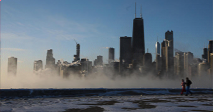
A fishing boat travels along the Mekong River as the sun rises
over Phnom Penh, Cambodia. From
bit.ly/2D0FA3g ...
Sending Pic:148x216C;

Three-month-old pigs run through an obstacle course to mark the
upcoming Lunar New Year of the Pig in Zhangjiakou, Hebei
Province, China. From
bit.ly/2CTVoos ...
Sending Pic:217x129C;

Sydney's iconic Sydney Opera House gets a red hue in honor of
Lunar New Year. From
cnn.it/2UsDMqU ..
Sending Pic:211x135C;

Our painting of the week is "Cold Winter Evening" by Suren
Nersisyan. From
bit.ly/2sVqXdc ...
Sending Pic:218x150C;
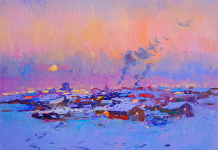
Shortwave Radiogram now returns to MFSK32 ...
RSID: <<2019-02-01T20:57Z
MFSK-32 @
7780000+1500>>
This is Shortwave Radiogram in MFSK32 ...
Transmission of Shortwave Radiogram is provided by:
WRMI, Radio Miami International, http://wrmi.net
WINB Shortwave, http://www.winb.com/
and
Space Line, Bulgaria, http://spaceline.bg
Please send reception reports to
radiogram@verizon.net
And visit http://swradiogram.net
Twitter:
@SWRadiogram
I'm Kim Elliott. Please join us for the next Shortwave
Radiogram.
|
Ending song SWRG: https://www.midomi.com/index.php?action=main.track&track_id=100319132741540671&from=voice_search
Gordon Lightfoot - Song For A Winter's Night https://www.youtube.com/watch?v=LfyDs6uXww0
|

RSID: <<2019-02-01T15:01Z
MFSK-32 @
13690000+1500>>
Welcome to program 85B of Shortwave Radiogram.
I'm Kim Andrew Elliott in Arlington, Virginia USA
This is a special broadcast of Shortwave Radiogram to test fast
digital text modes via DRM (Digital Radio Mondiale) audio.
Here is the lineup for this program, in modes as noted:
1:34 MFSK32: Program preview (now)
3:42 MFSK64: Immigrants' kids and STEM
5:57 MFSK128: Saturn's rings are relatively young
7:42 PSK-1000R: China's methane regulations
8:49 12xPSK125R: Stellar winds are surprisingly clumpy
9:38 6xPSK250R: Static electricity and battery life
10:32 3xPSK500R: Did collision give Earth stuff of life?
11:30 16xPSK125R: Sponsored news online
12:19 7xPSK250R: Massive black hole births
13:28 MFSK128: Trump casts doubt on climate change*
16:59 Study links climate change to Arab Spring migration*
19:29 World’s worst air is in South African coal community*
22:27 America's first Muslims were slaves*
26:49 MFSK32: Closing announcements
* with image
Please send reception reports to
radiogram@verizon.net
And visit http://swradiogram.net
Twitter:
@SWRadiogram
Shortwave Radiogram now changes to MFSK64 ...
RSID: <<2019-02-01T15:03Z
MFSK-64 @
13690000+1500>>
This is Shortwave Radiogram in MFSK64 ...
From Futurity.org:
Does language push immigrants kids toward STEM?
Posted by Jackie Ogburn
10 January 2019
US immigrant children study more math and science in high school
and college, which leads to a greater presence in STEM careers,
according to new research.
“Most studies on the assimilation of immigrants focus on the
language disadvantage of non-English-speaking immigrants,” says
Marcos Rangel, assistant professor at Duke University’s Sanford
School of Public Policy. “We focus instead on the comparative
strength certain immigrant children develop in numerical
subjects, and how that leads to majoring in STEM subjects in
college.”
About 20 percent of US-born college students major in STEM
subjects. Yet those numbers are much higher among
immigrants—particularly among those who arrive the US after age
10, and who come from countries whose native languages are
dissimilar to English, Rangel says. Within that group, 36 percent
major in STEM subjects.
“Some children who immigrate to the US, particularly older
children from a country where the main language is very
dissimilar to English, quite rationally decide to build on skills
they are relatively more comfortable with, such as math and
science,” says Rangel.
Those older immigrant children take more math and science courses
in high school, the authors say. Immigrant children arriving
after age 10 earn approximately 20 percent more credits in
math-intensive courses than they do in English-intensive courses.
This focus continues in college, where immigrant children are
more likely to pursue science, technology, engineering, and math
majors. Those majors, in turn, lead to careers in STEM fields.
Immigrants are more highly represented in many STEM careers,
according to previous research.
“Meaningful differences in skill accumulation… shape the
consequent contributions of childhood immigrants to the educated
labor force,” the authors, including Ying Shi from Stanford
University, write.
The researchers drew from nationally representative datasets
including the 2010-2016 waves of the American Community Survey,
the National Longitudinal Study of Adolescent Health, and the
National Survey of College Graduates.
The study appears online in the Proceedings of the National
Academy of Sciences.
The Early Childhood Initiative at the Duke Center for Child and
Family Policy and the Institute for Education Services funded the
study.
Source: Duke University
https://www.futurity.org/immigrant-kids-stem-1952602/
Shortwave Radiogram now changes to MFSK128 ...
RSID: <<2019-02-01T15:06Z
MFSK-128 @
13690000+1500>>
This is Shortwave Radiogram in MFSK128
Please send your reception report to
radiogram@verizon.net
From Futurity.org:
Saturn’s rings aren’t as old as some thought
Posted by Blaine Friedlander
23 January 2019
Saturn’s beautiful, extensive rings are relatively young, perhaps
created when dinosaurs roamed the Earth, according to new study.
Scientists drew the conclusion after finding that the ring’s mass
is less than previously thought and its frozen components are
surprisingly bright and free from dusty cosmic impurities.
“Based on previous research, we suspected the rings were young,
but not everyone was convinced,” says study coauthor Phil
Nicholson, professor of astronomy at Cornell University.
Before Cassini’s demise when it crashed into Saturn in September
2017, the spacecraft passed repeatedly between the rings and the
planet’s cloud tops to study Saturn’s gravity field and the
rings’ mass.
Cassini (and two Voyager spacecraft) had studied Saturn’s rings
from afar, but no craft had yet ventured into the rings to obtain
up-close data. Before its final planetary plunge, Cassini dove
through the rings 22 times, using six passes to measure the
gravity field by tracking the radio signal from the spacecraft.
(The technique is similar to a police radar, but more precise;
researchers measured Cassini with an accuracy of better than 0.1
millimeter per second.)
The scientists found that the rings—particularly the dense
B-ring, one of the three main rings and the brightest visible in
a telescope—had lower masses than many expected, indicating a
relatively young age. While Saturn is about 4.5 billion years
old, the new Cassini data indicate that the rings probably formed
between 10 million and 100 million years ago, according to the
researchers.
If interplanetary debris contaminated and darkened the rings over
a longer period, they would appear much darker, according to
NASA’s Jet Propulsion Laboratory.
“The new mass measurement is firm, because Cassini was able to
pass inside the rings. In our prior research, we used waves
driven in the rings by Saturn’s moons to indirectly estimate
their mass density at several locations, which we then
extrapolated to estimate the total mass of the rings,” says
Nicholson, who conducted the earlier research with Matt Hedman,
now an assistant professor of astronomy at the University of
Idaho. “Our final result was very close to the new measurement,
but lower than most earlier estimates.”
“From what we know based on Cassini’s spectral and radar
measurements, the rings are also less contaminated than
previously thought—probably less than 1 percent,” says Nicholson.
“They are close to pure water ice.”
In 2016, Zhimeng Zhang conducted work examining the dust content
of Saturn’s C ring. This research determined that the C ring,
once thought to have formed in the primordial era, was less than
100 million years old. In 2017, she and her colleagues reported
on similar measurements of the A and B rings, obtaining similarly
young ages.
“Think of an unused desk in an unused room. The more it sits
there, the more it collects dust,” Zhang said when she published
her work. “The C ring is the same way. While it is composed
mostly of water ice, it collects silicate-containing dust from
the far-off Kuiper Belt.… [I]n this case, the dust—in terms of
the age of the solar system—has not been here a long time.”
Among ring scientists, Nicholson and others wagered what Cassini
might find in terms of ring mass. The result was close to
Nicholson’s prediction.
“This is quite gratifying from a scientific and personal
point-of-view that we got close to the real number when Cassini
finally measured it,” he says.
The study appears in Science. Additional researchers are from
Sapienza University in Rome.
Source: Cornell University
https://www.futurity.org/saturn-rings-age-1964302/
Shortwave Radiogram now changes to PSK-1000R ...
RSID: <<2019-02-01T15:07Z
PSK-1000R @
13690000+1500>>
This is Shortwave Radiogram in PSK-1000R
Please send your reception report to
radiogram@verizon.net
From Futurity.org:
China’s new methane regulations aren’t working
Posted by Chanapa Tantibanchachai
29 January 2019
Despite tough new regulations on gas releases from its coal
mines, China continues to pump increasing amounts of
climate-changing methane into the atmosphere, a new study shows.
The country is already the world’s leading emitter of
human-caused greenhouse gases, researchers say.
“Our study indicates that, at least in terms of methane
emissions, China’s government is ‘talking the talk,’ but has not
been able to ‘walk the walk,'” says Scot Miller, assistant
professor of environmental health and engineering at Johns
Hopkins University and first author of the new paper in Nature
Communications.
China is the world’s largest producer and consumer of coal, which
accounts for approximately 72 percent of the country’s
electricity generation. While data show that coal production has
increased in China, it wasn’t clear until now how much methane
gas, or CH4, has increased.
Coal mine methane, or CH4 that is released during coal mining, is
responsible for the majority of coal-related CH4 emissions and is
likely the largest human-caused CH4 source in China.
In an effort to reduce coal mine methane, China enacted
regulations in 2010 that require mines to capture and use all
coal mine methane for electricity generation or heating, or to
flare it. (Flaring converts the CH4 into carbon dioxide, which
does not warm the climate as effectively as CH4.)
The country’s 12th Five-Year Plan, the communist government’s
strategy for economic and industrial development for 2011 through
2015, set a goal of capturing 8.4 billion cubic meters or 5.6
teragrams of coal mine methane by 2015.
The plan also targeted coal mine methane use of 20 billion cubic
meters or 13.2 teragrams by 2020. For context, China’s 2015
targets are equivalent to eliminating all methane emissions from
a country like Australia or Canada, and the 2020 targets are more
than twice that amount.
Satellite data
To examine how China’s methane emissions trended from 2010 to
2015, researchers used data from the Greenhouse Gases Observing
satellite, launched by the Japan Aerospace Exploration Agency in
2009 to collect observations of atmospheric methane and carbon
dioxide.
GOSAT is one of the first satellites to measure methane and
carbon dioxide with enough precision and accuracy to provide a
robust view into greenhouse gas emissions at the Earth’s surface.
The satellite’s nearly decade-long record of observations
provides researchers with the opportunity to examine annual
trends in greenhouse gas emissions across the globe.
While other studies used GOSAT data to focus on individual
regions like India or on individual years, this is the first time
researchers used the satellite’s observations to focus
specifically on trends in China’s methane emissions.
The findings show that methane emissions in China rose by
approximately 1.1 teragrams each year from 2010 to 2015,
resulting in about a 50 percent higher level of annual CH4
emissions by the end of the period, an increase that is
comparable to total emissions from countries like Russia or
Brazil.
Additionally, the increase from China accounts for 11 to 24
percent of the world’s total increase and is consistent with
trends prior to China’s 2010 policy implementation, which
suggests that the country’s regulations aren’t effective in
slashing methane emissions.
Image vs. reality
“China has received a lot of press coverage over the past few
years for its efforts to enact greenhouse gas regulations and its
efforts to become a leader on climate change, but the numbers
show that China’s methane regulations, in particular, have not
had any detectable impact on their emissions,” Miller says.
Some barriers to implement the coal mine methane policies include
subpar technology that can’t drain the methane in high-enough
quality for use and a lack of pipelines to transport the methane
from mines to power plants or central heating facilities.
Looking forward, Miller’s research team will examine how China
can most effectively implement its methane emission policies and
improve air quality.
Additional researchers are from the Carnegie Institution for
Science, the National Oceanic and Atmospheric Administration, the
Netherlands Institute for Space Research, and the University of
Colorado, Boulder. The Carnegie Institution and NASA funded the
work.
Source: Johns Hopkins University
https://www.futurity.org/china-methane-regulations-1968472-2/
Shortwave Radiogram now changes to 12xPSK125R
RSID: <<2019-02-01T15:09Z
12xPSK125R @
13690000+1500>>
This is Shortwave Radiogram in 12xPSK125R
Please send your reception report to
radiogram@verizon.net
From Futurity.org:
Stellar winds are surprisingly clumpy
Posted by Sam Sholtis
29 January 2019
NASA’s Chandra X-ray Observatory recorded data from a neutron
star as it passed through a dense patch of stellar wind emanating
from its massive companion star. It turns out that wind is
clumpy.
This provides valuable insight about the structure and
composition of stellar winds and about the environment of the
neutron star itself.
“Stellar winds are the fast-flowing material—composed of protons,
electrons, and metal atoms—ejected from stars,” says Pragati
Pradhan, a postdoctoral researcher in astronomy and astrophysics
at Penn State and the lead author of the paper. “This material
enriches the star’s surroundings with metals, kinetic energy, and
ionizing radiation. It is the source material for star formation.
“Until the last decade, it was thought that stellar winds were
homogenous, but these Chandra data provide direct evidence that
stellar winds are populated with dense clumps.”
Binary systems
The neutron star observed is part of a high-mass X-ray binary
system—the compact, incredibly dense neutron star paired with a
massive “normal” supergiant star. Neutron stars in binary systems
produce X-rays when material from the companion star falls toward
the neutron star and is accelerated to high velocities. As a
result of this acceleration, X-rays are produced that can in turn
interact with the materials of the stellar wind to produce
secondary X-rays of signature energies at various distances from
the neutron star.
Neutral—uncharged—iron atoms, for example, produce fluorescence
X-rays with energies of 6.4 kilo-electron volts (keV), roughly
3,000 times the energy of visible light. Astronomers use
spectrometers, like the instrument on Chandra, to capture these
X-rays and separate them based on their energy to learn about the
compositions of stars.
“Neutral iron atoms are a more common component of stars so we
usually see a large peak at 6.4 keV in the data from our
spectrometers when looking at X-rays from most neutron stars in a
high-mass X-ray binary system,” says Pradhan.
“When we looked at X-ray data from the high-mass X-ray binary
system known as OAO 1657-415 we saw that this peak at 6.4 keV had
an unusual feature. The peak had a broad extension down to 6.3
keV. This extension is referred to as a ‘Compton shoulder’ and
indicates that the X-rays from neutral iron are being back
scattered by dense matter surrounding the star. This is only the
second high-mass X-ray binary system where such a feature has
been detected.”
NuSTAR next
The researchers also used the Chandra’s state-of-the-art
engineering to identify a lower limit on the distance from the
neutron star that the X-rays from neutral iron are formed. Their
spectral analysis showed that neutral iron is ionized at least
2.5 light-seconds, a distance of approximately 750 million meters
or nearly 500,000 miles, from the neutron star to produce X-rays.
“In this work, we see a dimming of the X-rays from the neutron
star and a prominent line from neutral iron in the X-ray
spectrum—two signatures supporting the clumpy nature of stellar
winds,” says Pradhan. “Furthermore, the detection of Compton
shoulder has also allowed us to map the environment around this
neutron star. We expect to be able to improve our understanding
of these phenomenon with the upcoming launch of spacecrafts like
Lynx and Athena, which will have improved X-ray spectral
resolution.”
For Pradhan’s postdoctoral work, she is majorly involved in
writing algorithms for on-board detection of X-rays from
transient astronomical events such as those seen from these
high-mass X-ray binary systems for instruments that will be on
the Athena spacecraft.
Pradhan and her team also have a follow-up campaign looking at
the same high-mass X-ray binary with another NASA
satellite—NuSTAR, which will cover a broader spectrum of X-rays
from this source ranging in energies from ~ 3 to 70 keV—in May
2019.
“We are excited about the upcoming NuSTAR observation too,” says
Pradhan. “Such observations in hard X-rays will add another
dimension to our understanding of the physics of this system and
we will have an opportunity to estimate the magnetic field of the
neutron star in OAO 1657-415, which is likely a million times
stronger than strongest magnetic field on Earth.”
A paper describing the research appears in Monthly Notices of the
Royal Astronomical Society. In addition to Pradhan, the research
team for this paper includes researchers at the Raman Research
Institute in Bangalore, India.
Source: Penn State
https://www.futurity.org/clumpy-stellar-winds-1968022-2/
Shortwave Radiogram now changes to 6xPSK250R ...
RSID: <<2019-02-01T15:09Z
6xPSK250R @
13690000+1500>>
This is Shortwave Radiogram in 6xPSK250R
Please send your reception report to
radiogram@verizon.net
From Futurity.org:
Static electricity mystery paves way for better battery life
Posted by Cory Nealon
25 January 2019
A new, simple, and inexpensive method uses ultraviolet light to
control particle motion and assembly within liquids.
The method could improve drug delivery, chemical sensors, and
fluid pumps. It encourages particles—from plastic microbeads, to
bacterial spores, to pollutants—to gather and organize at a
specific location within a liquid and, if researchers want, to
move to new locations.
“Many applications related to sensors, drug delivery, and
nanotechnology require the precise control of the flow of
fluids,” says senior author Ayusman Sen, professor of chemistry
at Penn State. “Researchers have developed a number of strategies
to do so, including nanomotors and fluid pumps, but prior to this
study we did not have an easy way to gather particles at a
particular location so that they can perform a useful function
and then move them to a new location so they can perform the
function again.
Speck stampede
“Say for example you want to build a sensor to detect particles
of a pollutant, or bacterial spores in a water sample,” says Sen.
“With this new method, we can simply add nanoparticles of gold or
titanium dioxide and shine a light to encourage the pollutant
particles or spores to gather. By concentrating them in one spot,
they become easier to detect. And because light is so easy to
manipulate, we have a high degree of control.”
Just as researchers could gather pollutant particles at a
particular location, the method could gather silica or polymer
beads that carry a payload, like antibodies or drugs, at
particular locations within a fluid.
The new method first involves adding a small amount of titanium
dioxide or gold nanoparticles to a liquid, like water, that also
contains larger particles of interest, like pollutants or beads
carrying a payload. Shining a light at a specific point in the
liquid heats up the tiny metal nanoparticles, and the heat then
transfers to the fluid. The warmer liquid then rises at the point
of light—just as warm air rises in a chilly room—and cooler water
rushes in to fill the space that the warm water just left,
bringing the larger particles with it.
“This causes the larger particles to collect at the point of UV
light, where they form closely packed, well-organized structures
called colloidal crystals,” says first author Benjamin Tansi, a
graduate student in chemistry. “Changing the intensity of the
light or the amount of titanium dioxide or gold particles alters
how quickly this process occurs.”
When researchers remove the light, the larger particles randomly
diffuse through the liquid. But if they relocate the light
instead, the larger particles move toward the new point of light,
mostly maintaining their structure as they move. This dynamic
assembly, disassembly, and movement of organized particles may
have important implications for sensing and drug delivery.
“This process is most efficient when gold nanoparticles are used,
but we wanted to find an alternative that was less expensive and
more accessible,” says Tansi. “We were pleased to find that this
method also works with titanium dioxide, an inexpensive and
harmless nanoparticle used in cosmetics and as a food additive.”
Creating a flow
In addition to water, the researchers demonstrated the
effectiveness of this method in hexadecane, an organic liquid.
“Particles usually don’t assemble very well in salty or
non-aqueous environments because everything sticks together,”
says Sen. “But here we show that particles can assemble using
this method in hexadecane, which suggests we may be able to apply
this technique in, for example, biological fluids. To our
knowledge this is the first demonstration of light-driven fluid
pumping in an organic medium.”
Researchers used mathematical models to describe the dynamics of
the system. In addition to describing how particles move in the
system, the models confirm that only a minor change in
temperature—less than a degree Celsius—from the ultraviolet light
is necessary to induce the fluid flow.
The research team is currently testing the limits of this method,
for example if particles can move uphill toward the light source
or if the method can help sort particles by size.
“We knew that heating gold nanoparticles in suspension could
create a fluid flow,” says Tansi, “but prior to this study no one
had looked to see if these kinds of thermally-driven fluid flows
could be used to do anything useful.
“Because ultraviolet light and titanium dioxide are so easy to
control, we think this method could be harnessed in various
technologies in the future. For example, a fluid pump that relies
on this method could potentially replace the bulky and more
expensive traditional pumps that require a power source or that
rely on magnetics or mechanical movement to function,” Tansi
says.
The paper appears in the journal Angewandte Chemie. Additional
researchers Penn State and the University of Pittsburgh
contributed to the work. The National Science Foundation funded
the research.
Source: Penn State
https://www.futurity.org/uv-light-fluid-nanoparticles-1963182/
Shortwave Radiogram now changes to 3PSK500R ...
RSID: <<2019-02-01T15:10Z 3xPSK500R @ 13690000+1500>>
This is Shortwave Radiogram in 3PSK500R ...
Please send your reception report to
radiogram@verizon.net
From Futurity.org:
Did a planetary collision give Earth the stuff for life?
Posted by Jade Boyd
24 January 2019
Earth most likely received the bulk of its carbon, nitrogen, and
other life-essential volatile elements from the planetary
collision that created the moon more than 4.4 billion years ago,
according to a new study.
“From the study of primitive meteorites, scientists have long
known that Earth and other rocky planets in the inner solar
system are volatile-depleted,” says study coauthor Rajdeep
Dasgupta.
“But the timing and mechanism of volatile delivery has been hotly
debated. Ours is the first scenario that can explain the timing
and delivery in a way that is consistent with all of the
geochemical evidence.”
Elemental evidence
The researchers compiled the evidence from a combination of
high-temperature, high-pressure experiments in Dasgupta’s lab,
which specializes in studying geochemical reactions that take
place deep within a planet under intense heat and pressure.
In a series of experiments, lead author and graduate student
Damanveer Grewal gathered evidence to test a long-standing theory
that Earth’s volatiles arrived from a collision with an embryonic
planet that had a sulfur-rich core.
The sulfur content of the donor planet’s core matters because of
the puzzling array of experimental evidence about the carbon,
nitrogen, and sulfur that exist in all parts of the Earth other
than the core.
“The core doesn’t interact with the rest of Earth, but everything
above it, the mantle, the crust, the hydrosphere and the
atmosphere, are all connected,” Grewal says. “Material cycles
between them.”
One long-standing idea about how Earth received its volatiles was
the “late veneer” theory that volatile-rich meteorites, leftover
chunks of primordial matter from the outer solar system, arrived
after Earth’s core formed. And while the isotopic signatures of
Earth’s volatiles match these primordial objects, known as
carbonaceous chondrites, the elemental ratio of carbon to
nitrogen is off. Earth’s non-core material, which geologists call
the bulk silicate Earth, has about 40 parts carbon to each part
nitrogen, approximately twice the 20-1 ratio seen in carbonaceous
chondrites.
Grewal’s experiments, which simulated the high pressures and
temperatures during core formation, tested the idea that a
sulfur-rich planetary core might exclude carbon or nitrogen, or
both, leaving much larger fractions of those elements in the bulk
silicate as compared to Earth. In a series of tests at a range of
temperatures and pressure, Grewal examined how much carbon and
nitrogen made it into the core in three scenarios: no sulfur, 10
percent sulfur, and 25 percent sulfur.
“Nitrogen was largely unaffected,” he says. “It remained soluble
in the alloys relative to silicates, and only began to be
excluded from the core under the highest sulfur concentration.”
Carbon, by contrast, was considerably less soluble in alloys with
intermediate sulfur concentrations, and sulfur-rich alloys took
up about 10 times less carbon by weight than sulfur-free alloys.
Using this information, along with the known ratios and
concentrations of elements both on Earth and in non-terrestrial
bodies, Dasgupta, Grewal, and postdoctoral researcher Chenguang
Sun designed a computer simulation to find the most likely
scenario that produced Earth’s volatiles. Finding the answer
involved varying the starting conditions, running approximately 1
billion scenarios, and comparing them against the known
conditions in the solar system today.
Moon-making impact
“What we found is that all the evidence—isotopic signatures, the
carbon-nitrogen ratio, and the overall amounts of carbon,
nitrogen, and sulfur in the bulk silicate Earth—are consistent
with a moon-forming impact involving a volatile-bearing,
Mars-sized planet with a sulfur-rich core,” Grewal says.
Dasgupta, the principal investigator on a NASA-funded effort
called CLEVER Planets exploring how life-essential elements might
come together on distant rocky planets, says better understanding
the origin of Earth’s life-essential elements has implications
beyond our solar system.
“This study suggests that a rocky, Earth-like planet gets more
chances to acquire life-essential elements if it forms and grows
from giant impacts with planets that have sampled different
building blocks, perhaps from different parts of a protoplanetary
disk,” Dasgupta says.
“This removes some boundary conditions,” he says. “It shows that
life-essential volatiles can arrive at the surface layers of a
planet, even if they were produced on planetary bodies that
underwent core formation under very different conditions.”
Dasgupta says it does not appear that Earth’s bulk silicate, on
its own, could have attained the life-essential volatile budgets
that produced our biosphere, atmosphere, and hydrosphere.
“That means we can broaden our search for pathways that lead to
volatile elements coming together on a planet to support life as
we know it.”
The study appears in Science Advances.
NASA, the Deep Carbon Observatory, and the David and Lucile
Packard Foundation supported the research.
CLEVER Planets is part of the Nexus for Exoplanet System Science,
or NExSS, a NASA astrobiology research coordination network
dedicated to the study of planetary habitability. CLEVER Planets
involves more than a dozen research groups from Rice; NASA’s
Johnson Space Center; the University of California, Los Angeles;
the University of Colorado Boulder; and the University of
California, Davis.
Source: Rice University
https://www.futurity.org/life-on-earth-planetary-collision-1965222/
Shortwave Radiogram now changes to 16xPSK125R ...
RSID: <<2019-02-01T15:11Z
16xPSK125R @
13690000+1500>>
This is Shortwave Radiogram in 16xPSK125R
Please send your reception report to
radiogram@verizon.net
From Futurity.org:
9 in 10 people can't tell sponsored stuff from real news online
Posted by Kat McAlpine
18 January 2019
There are all kinds of ways to avoid advertising, such as using
ad-blocker software, fast-forwarding through commercials, or
choosing ad-free media streaming services like Netflix. This has
forced advertisers to get creative to put their messages in front
of digital consumers. Also known as sponsored content, native
advertising inserts paid messaging right into the mix alongside
news articles.
Buzzfeed was an early adopter of native advertising as a
profit-making model, but these days the New York Times, Wall
Street Journal, Washington Post, Boston Globe, and nearly all
major news sites are profiting from content for which advertisers
pay. One estimate from Forbes says that native ads will be a $21
billion industry by 2021 and account for nearly 75 percent of all
ad revenue by then.
Not only is there more content like this, it's better, too. So
much better that it's beginning to fake out readers. And that's
troubling, says Michelle Amazeen, an assistant professor of
advertising at the Boston University School of Communication.
In her new research, even though her online survey told
participants that they were viewing advertisements, many
people - more than 9 out of 10 - thought they were looking at an
article.
"I think it's contributing to people thinking that news media are
sharing fake news," says Amazeen, corresponding author of the
study, which appears in Mass Communication and Society.
Ad or article?
During the online experiment, Amazeen and her collaborator,
Bartosz Wojdynski of the University of Georgia, surveyed 738
adults - a cross section of people of all ages, with varying
degrees of education, both married and single, and from across
the political spectrum.
During the survey, the participants viewed content from an actual
Bank of America advertisement, a 515-word piece titled "America's
Smartphone Obsession Extends to Online Banking," which
Brandpoint, a content marketing agency, created for the bank.
Participants viewed the advertisement, which included a
disclosure identifying it as an ad - the Federal Trade Commission
requires that advertisers include such a disclosure - and then
answered a series of questions.
Amazeen found that among the fewer than 1 in 10 individuals who
were able to identify the Bank of America piece as advertising,
people tended to be younger, more educated, and more likely to
describe their engagement with news media as for informational
purposes. In contrast, people who mistook the advertisement for a
legitimate news article were generally older, less educated, and
more likely to consume news media for entertainment purposes.
"We found that people are more receptive to what they're looking
at if they know what they're reading," Amazeen says, even if they
know they're reading an ad.
If, on the other hand, an advertiser makes it difficult to detect
content as an ad, a substantial amount of people have negative
reactions when they realize the truth.
"A lot of people equate this to fake news," Amazeen says. "Trust
in media is at an all-time low... . I'm not suggesting it's only
from native advertising, but I think it's a contributing factor."
Is a 'sponsored content' label enough?
Although advertisers are required to disclose their ads as such,
typically with a label like "sponsored" or "paid promotion," not
all disclosures are the same. Depending on size, placement, and
other factors, some advertisers and publishers are more upfront
than others about the nature of their content. Amazeen says the
lack of standardized requirements for native ad disclosures is
fueling the problem of people not recognizing what's a sponsored
story and what's a news story.
One big risk, Amazeen says, is that if someone doesn't realize
they're looking at promoted content, they may think they're
getting the whole story on a given topic.
"Advertising is supposed to be true and accurate, according to
the Federal Trade Commission," Amazeen says. But, ads often
"leave out certain information that isn't favorable for whatever
perspective they are trying to convey."
In an effort to combat public distrust, some news organizations
are taking more aggressive initiatives to help readers identify
real content versus sponsored content. But, with native
advertisements peppering most newsfeeds, a state of constant
confusion over content - what is editorial, what is sponsored, and
what is just outright fake - is muddying the waters.
'Shooting themselves in the foot'
"A lot of legacy and digital-only news organizations do fantastic
investigative reporting and break important stories, but at the
same time, they're shooting themselves in the foot," Amazeen
says.
Politico, for example, runs a fake news database, filled with
news stories that its reporters or readers have found to contain
doctored videos, images, or hoax-like disinformation. However,
Politico's own news feed is sporadically interspersed with
advertisers' articles labeled as sponsored.
"Politico's concern with the origins of political disinformation
seems pretty rich given its work with Cambridge Analytica,"
Amazeen wrote in an October 2018 tweet.
During the 2016 presidential campaign, political consulting firm
Cambridge Analytica helped target 10,000 ads to different
audiences. Brittany Kaiser, who was Cambridge Analytica's
business development director at the time, called one native
advertisement on Politico, "the most successful thing we pushed
out."
In March 2018, an article in the Guardian reported, "One of the
most effective ads, according to Kaiser, was a piece of native
advertising on the political news website Politico, which was
also profiled in the presentation. The interactive graphic, which
looked like a piece of journalism and purported to list '10
inconvenient truths about the Clinton Foundation,' appeared for
several weeks to people from a list of key swing states when they
visited the site. It was produced by the in-house Politico team
that creates sponsored content."
The advertisement on Politico, which was labeled at the top as
"sponsor-created content" and "paid advertisement for and created
by Donald J. Trump," garnered an average of four minutes of
engagement from its readers in key swing states.
"The line of caution is when you start mixing news with
advertisements and blurring those lines - that's where you have to
take a step back and really think about what you're doing,"
Amazeen says.
The American Press Institute funded the research.
Source: Boston University
https://www.futurity.org/sponsored-content-real-news-1961062/
Shortwave Radiogram now changes to 7xPSK250R
RSID: <<2019-02-01T15:12Z
7xPSK250R @
13690000+1500>>
This is Shortwave Radiogram in 7xPSK250R ...
Please send your reception report to
radiogram@verizon.net
From Futurity.org:
Simulation upends ideas about massive black hole births
Posted by John Toon
28 January 2019
Massive black holes form in dense starless regions that are
growing rapidly, according to a new study.
The finding turns upside down the long-accepted belief that
massive black hole formation was limited to regions under
bombardment by the powerful radiation of nearby galaxies.
The light released from around the first massive black holes in
the universe is so intense that it is able to reach telescopes
across the entire expanse of the universe. Incredibly, the light
from the most distant black holes (or quasars) has been traveling
to us for more than 13 billion light years. However, we don’t
know how these monster black holes formed.
The new research provides a new and extremely promising avenue
for solving this cosmic riddle. The team showed that when
galaxies assemble extremely rapidly—and sometimes violently—that
can lead to the formation of very massive black holes. In these
rare galaxies, normal star formation is disrupted and black hole
formation takes over.
The simulation-based study, also finds that massive black holes
are much more common in the universe than previously thought.
Dark matter halos
The key criteria for determining where massive black holes formed
during the universe’s infancy relates to the rapid growth of
pre-galactic gas clouds that are the forerunners of all
present-day galaxies, meaning that most supermassive black holes
have a common origin forming in this newly discovered scenario,
says John Wise, an associate professor in the Center for
Relativistic Astrophysics in Georgia Tech’s School of Physics and
the paper’s corresponding author.
Dark matter collapses into halos that are the gravitational glue
for all galaxies. Early rapid growth of these halos prevented the
formation of stars that would have competed with black holes for
gaseous matter flowing into the area.
“In this study, we have uncovered a totally new mechanism that
sparks the formation of massive black holes in particular dark
matter halos,” Wise says.
“Instead of just considering radiation, we need to look at how
quickly the halos grow. We don’t need that much physics to
understand it—just how the dark matter is distributed and how
gravity will affect that. Forming a massive black hole requires
being in a rare region with an intense convergence of matter.”
When the research team found these black hole formation sites in
the simulation they were stumped at first, says John Regan,
research fellow in the Centre for Astrophysics and Relativity in
Dublin City University. The previously accepted paradigm was that
massive black holes could only form when exposed to high levels
of nearby radiation.
“Previous theories suggested this should only happen when the
sites were exposed to high levels of star-formation killing
radiation,” he says.
“As we delved deeper, we saw that these sites were undergoing a
period of extremely rapid growth. That was the key. The violent
and turbulent nature of the rapid assembly, the violent crashing
together of the galaxy’s foundations during the galaxy’s birth
prevented normal star formation and led to perfect conditions for
black hole formation instead. This research shifts the previous
paradigm and opens up a whole new area of research.”
The earlier theory relied on intense ultraviolet radiation from a
nearby galaxy to inhibit the formation of stars in the black
hole-forming halo, says coauthor Michael Norman, director of the
San Diego Supercomputer Center at the University of California,
San Diego.
“While UV radiation is still a factor, our work has shown that it
is not the dominant factor, at least in our simulations,” he
explains.
Supercomputer simulation
Researchers based their work on the Renaissance Simulation suite,
a 70-terabyte data set created on the Blue Waters supercomputer
between 2011 and 2014 to help scientists understand how the
universe evolved during its early years.
To learn more about specific regions where massive black holes
were likely to develop, the researchers examined the simulation
data and found ten specific dark matter halos that should have
formed stars given their masses but only contained a dense gas
cloud.
Using the Stampede2 supercomputer, they then re-simulated two of
those halos—each about 2,400 light-years across—at much higher
resolution to understand details of what was happening in them
270 million years after the Big Bang.
“It was only in these overly-dense regions of the universe that
we saw these black holes forming,” Wise says. “The dark matter
creates most of the gravity, and then the gas falls into that
gravitational potential, where it can form stars or a massive
black hole.”
The Renaissance Simulations are the most comprehensive
simulations of the earliest stages of the gravitational assembly
of the pristine gas composed of hydrogen and helium and cold dark
matter leading to the formation of the first stars and galaxies.
They use a technique known as adaptive mesh refinement to zoom in
on dense clumps forming stars or black holes.
In addition, the simulations cover a large enough region of the
early universe to form thousands of objects—a requirement if one
is interested in rare objects, as is the case here.
“The high resolution, rich physics, and large sample of
collapsing halos were all needed to achieve this result,” says
Norman.
More common than we thought
The improved resolution of the simulation done for two candidate
regions allowed the scientists to see turbulence and the inflow
of gas and clumps of matter forming as the black hole precursors
began to condense and spin. Their growth rate was dramatic.
“Astronomers observe supermassive black holes that have grown to
a billion solar masses in 800 million years,” Wise says. “Doing
that required an intense convergence of mass in that region. You
would expect that in regions where galaxies were forming at very
early times.”
Another aspect of the research is that the halos that give birth
to black holes may be more common than previously believed.
“An exciting component of this work is the discovery that these
types of halos, though rare, may be common enough,” says Brian
O’Shea, a professor at Michigan State University. “We predict
that this scenario would happen enough to be the origin of the
most massive black holes that are observed, both early in the
universe and in galaxies at the present day.”
Future work with these simulations will look at the lifecycle of
these massive black hole formation galaxies, studying the
formation, growth, and evolution of the first massive black holes
across time.
“Our next goal is to probe the further evolution of these exotic
objects. Where are these black holes today? Can we detect
evidence of them in the local universe or with gravitational
waves?” Regan asks.
For these new answers, the research team—and others—may return to
the simulations.
“The Renaissance Simulations are sufficiently rich that other
discoveries can be made using data already computed,” says
Norman. “For this reason we have created a public archive at SDSC
containing called the Renaissance Simulations Laboratory where
others can pursue questions of their own.”
The findings appear in the journal Nature.
Funding for the work came from the National Science Foundation,
the European Union, and NASA. Additional researchers from Georgia
Tech; Dublin City University; Michigan State University; the
University of California, San Diego; the San Diego Supercomputer
Center and IBM
The researchers performed the simulation on the Blue Waters
supercomputer that the National Center for Supercomputing
Applications operates with PRAC allocation support from the NSF.
Any opinions, findings, and conclusions or recommendations
expressed in this material are those of the authors and do not
necessarily reflect the views of the sponsor organizations.
Source: Georgia Tech
https://www.futurity.org/black-hole-simulations-1967042/
Shortwave Radiogram now returns to MFSK128 ...
RSID: <<2019-02-01T15:13Z
MFSK-128 @
13690000+1500>>
This is Shortwave Radiogram in MFSK128
Please send your reception report to
radiogram@verizon.net
From Voice of America:
As Arctic Chill Hits US, Trump Again Casts Doubt on Climate
Change
Steve Herman, W7VOA
WHITE HOUSE - A Tuesday tweet from a U.S. government scientific
agency seems relatively innocuous: “Winter storms do not prove
global warming is not happening.”
The message from the National Oceanic and Atmospheric
Administration (NOAA), which is devoted to climate science and
information, includes a link citing research that severe
snowstorms may be even more likely in a warming global climate
because higher ocean temperatures appear to create more moisture.
Many are viewing Tuesday's post as a rebuttal to President
Trump’s tweet late Monday noting an approaching deep freeze for
the American Midwest and asking “What the hell is going on with
Global Waming (sic). Please come back fast, we need you.”
A polar vortex has returned this week to the Midwest bringing
extremely low temperatures that could break records.
NOAA denies any connection between the president’s comment and
its social media posting.
“We routinely put this story out at these times,” the agency said
in a statement. “Our scientists weren’t responding to a tweet.”
Most scientists say there is little valid research to counter the
prevailing view climate change is real and note research also
demonstrates that with global warming there will be more
frequently extreme temperatures at both ends of the thermometer.
With a forecast of icy roads around the nation’s capital, one
item of unanimous consent throughout the Trump administration
Tuesday is non-emergency federal workers – just two days back on
the job after a record-long shutdown – could leave early because
of the weather.
“Employees of Federal offices in the Washington, D.C., area are
authorized for early departure,” according to a notice from the
U.S. Office of Personnel Management. “Employees should depart 2
hours earlier than their normal departure times and may request
unscheduled leave to depart prior to their staggered departure
times.”
The notification is intended, in part, to alleviate congestion on
streets that could soon become hazardous.
The ability of a mere dusting of snow or sheets of ice on
roadways and sidewalks to create pandemonium in the U.S. center
of power frequently puzzles those who have migrated to this part
of the country from harsher winter climates.
A January 2016 snowstorm paralyzed the region, although only 2.5
centimeters of snow fell on Washington, D.C. roadways. There were
hundreds of traffic accidents and many motorists abandoned their
vehicles on highways after untreated roads became impassible with
black ice.
The mess and lack of preparedness prompted a public apology by
the mayor of Washington, D.C.
Muriel Bowser was taking no such chances on Tuesday, three years
after the so-called Snowzilla (not to be confused with the area’s
December 2009 Snowpocalypse).
Mayor Bowser, on Tuesday announced she had requested an
additional $1 million from the city’s contingency fund “to cover
higher costs than anticipated for salt/de-icing as a result of
Winter Storm Gia.”
The city also issued a hypothermia alert, which will keep
shelters open during daylight hours so the estimated 7,000
homeless people in Washington will have a warm and safe place to
stay.
A member of Congress from Utah, as government employees began
packing up early in the afternoon, on Tuesday threw his own
virtual snowball at the threat of another approaching winter
storm appearing to panic politicians, bureaucrats and lobbyists
inside the Beltway.
“People in DC love to show how tough they are and call their
opponents ‘snowflake,’” wrote Congressman Ben McAdams on Twitter.
“Unless the weather forecast includes snowflakes, and then they
cancel meetings, leave work early and buy all of the bottled
water at the grocery store. Snowflakes.” He then tossed a
promotional hashtag for a top winter recreational activity in his
state that includes the Wasatch Mountain range: #SkiUtah.
https://www.voanews.com/a/as-arctic-chill-hits-us-trump-again-casts-doubt-on-climate-change/4764109.html
Image: A Moorhead, Minnesota elementary school electronic sign
shows to temperature, Jan. 29, 2019 ...
Sending Pic:221x140C;
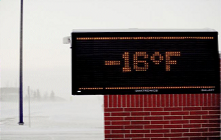
From the Voice of America:
Study: Climate Change Linked to 'Arab Spring' Mass Migration
Henry Ridgewell
29 January 2019
LONDON - For the first time, scientists have linked climate
change to the mass migration flows that followed the Arab Spring
in North Africa and the Middle East a few years ago.
According to scientists from the International Institute for
Applied Systems Analysis in Austria, water shortages and droughts
contributed to the Arab Spring conflicts, particularly in Syria,
which remains mired in a civil war.
“People started not being able to produce agricultural
production, and that was the start of migration from the rural
areas to urban areas, which were already quite crowded. And the
resources in the urban areas were also scarce. So with that kind
of tension, fighting for limited resources, and on top is the
ethnic polarization in Syria. So, it’s sort of all that
combination,” said Raya Muttarak, of the University of East
Anglia in Britain. She co-authored a report on the subject.
The researchers used United Nations’ data on asylum applications
and conflict-related deaths. They combined this with data on
drought and rainfall, plus other variables like population size
and measures of democracy and ethnic diversity. All the figures
were combined in a mathematical model.
“So, let’s look at how climate affects the probability of
conflict. And once we estimate that we use the number that we got
from that to estimate the next step. So, the countries that
experience conflict from climate variation — are they likely to
send out the refugee flows or not?” explained Muttarak.
She said that climate change would not cause conflict and
subsequent asylum-seeking flows everywhere.
“The effect of climate on migration, through conflict, is quite
specific to certain time periods and to certain countries. So,
climate-induced conflict, it’s a bit more likely in a country
with a medium level of democracy.”
The results of this study are specific to the western Asia
region. However, researchers say they hope the study will
contribute to the global debate on how migration flows will be
affected by increasingly severe climate change.
https://www.voanews.com/a/migration-conflicts-stem-from-climate-change/4763191.html
Image: Screen capture from the accompanying video ...
Sending Pic:130x224C;

From the Voice of America:
World’s Worst Air is in S. African Coal Community
Anita Powell
30 January 2019
MIDDELBURG, SOUTH AFRICA - Thirty-five-year-old Patrick Mdluli
considered himself healthy until he moved two years ago to
Mpumalanga province - South Africa’s coal mining heartland.
The area has the worst air quality in the world, according to a
recent study by environmental group Greenpeace. The 12 large coal
mines in this area make it the world’s hotspot for toxic nitrogen
dioxide emissions.
Soon, Mdluli said, he began to develop health problems, including
tuberculosis and nasal issues.
“The mines, the dust, pollution - you go to doctors, they tell
you the very same thing," he said. "‘Are you living next to a
mine?’ Yes, I am. ‘Are you living next to a dumping site?’ Yes, I
am.”
A large coal mine operates, literally, in Mdluli’s backyard. The
mine has conducted blasts every day, shaking his small home to
its foundation, filling the rooms with dust and causing a large
crack in the wall. Residents in this impoverished area complain
that their walls are crumbling because of the incessant blasts.
But the real damage is on the inside, says the head of one of
Middelburg’s main clinics, Dr. Mohammed Tayob.
Tayob has lived in the area his entire life and says the
emissions from the mines have made many of his patients sick. In
his lifetime, he says, he's seen a flurry of new mine openings in
the area as the nation has tried to profit off its vast coal
reserves.
“Children and adults are paying the ultimate price," he told
VOA." When we say ultimate price, it’s the loss of neurocognitive
development, children’s infant mortality rate is higher in our
area than other areas, adults, heart attacks and respiratory
diseases are much higher. So people are paying with their lives,
across the board, because of these pollutants in the air.”
Although mines are big money, locals say the coal companies have
done little to improve the community. Middelburg is poor and many
people lack basic services like electricity and running water.
Tayob says the government is also failing to enforce
environmental laws and crack down on the mines. He blames the
coal mining industry and poor governance for the current
situation. Corruption scandals are prevalent in South Africa, and
often grab headlines.
“One cannot be faulted in thinking, ‘Is there some level of
corruption operating in this area as well, where these big boys
are getting away with murder, literally?’ he said. "They’re
literally getting away with murder. It's just the reality. I’d
like someone to come up and dispute this fact and challenge me on
that.”
VOA contacted three of the larger mines in the area for comment.
None responded to our request.
Environmental activist Bafana Hlatshwayo says he and other
activists are preparing to lobby decision-makers at an upcoming
mining industry gathering in Cape Town.
They want the coal industry to shift to a cleaner resource: the
region’s abundant sunshine.
Bringing solar panel production to the area, says Hlatshwayo,
would also create jobs.
“We are not saying we want to close down the mines," he said.
"...We must go the renewable energy way, we are saying, people
will manufacture solar panels inside South Africa, and they are
the ones who are supposed to install the solar panels and they
are the ones who are supposed to maintain the solar panels.”
But that is a faraway dream for people like Mdluli and his
neighbors, who complain unemployment is high and all of them -
including the children - have health problems.
This province, says longtime resident and environmental activist
William Jiyane, used to be beautiful.
“It’s endless agony, now, Mpumalanga," he said, standing in a
neighbor's yard, and gesturing at a belching mine. "It’s not
bread and butter anymore. It’s endless agony.”
https://www.voanews.com/a/world-s-worst-air-in-south-african-coal-community/4763639.html
Image: Screen capture from the accompanying video ...
Sending Pic:223x114C;

From the Voice of America:
America's First Muslims Were Slaves
Dora Mekouar
29 January 2019
In 1807, a wealthy 37-year-old scholar was captured in West
Africa, in what is now Senegal, and transported to the United
States to be sold into slavery.
That man, Omar Ibn Said, lived the remainder of his life enslaved
in the American South, and his story might have been forgotten if
not for the handwritten autobiography he left behind.
Written in Arabic and recently acquired by the Library of
Congress, "The Life of Omar Ibn Said” is not only a rare
handwritten personal story of an American slave, but it's also
one of the first intimate accounts of the early history of
Muslims in the United States.
Ibn Said was among the approximately one-third of American slaves
who were Muslim. While the exact number of enslaved Muslims is
unknown, up to 40 percent of those who were captured and enslaved
came from predominantly Muslim parts of West Africa.
“It challenges this notion of this being a Christian nation,"
says Zaheer Ali, an oral historian at the Brooklyn Historical
Society and project director of the Muslims in Brooklyn project.
"It opens us up to understanding that there were non-Christians
present at the founding of this nation, and not only at the
founding of this nation, but that helped build this nation...It
challenges the idea that this was a quote ‘Christian nation’ from
the beginning.”
America's first Muslims were slaves
The subsequent erasure of the black Muslim identity among the
enslaved people in the United States was part of a strategy to
strip enslaved Africans of their individual identities and reduce
them to chattel both legally and in the public imagination.
"The black classification was devised to mark enslaved Africans
as property. So, if you were black, you were no longer a human
being," says Khaled Beydoun, an author and law professor at the
University of Arkansas. "If you acknowledge some of these
religious identities, then you're in turn acknowledging their
humanity."
During the antebellum period in the South, the Muslim identity
took on very different identity from the stereotype of an African
slave.
"When people thought of a Muslim at that time, they thought Arab,
they thought Ottoman, they thought Middle Eastern," Beydoun says.
"Enslaved Africans did not fit within that racial ethnic
caricature or form."
This narrow understanding of both Muslims and Africans led to the
widespread belief that the two identities could not overlap and
helped hasten the erasure of Muslim African slaves from the
historical record. In addition, the names of enslaved Muslims
were often anglicized, which further obscured them from the
history.
Writing themselves into history
Enslaved Muslims who left behind a written record challenged the
idea that enslaved men and women were a brute workforce solely
capable of physical labor because they lacked the intellectual
capacity that would make them deserving of independence and
freedom.
“These were people who were essentially writing themselves into
existence both in terms of leaving a record of their life but
also in terms of challenging the racist assumptions about people
of African descent," Ali says.
What we know about the masses of African Muslim slaves who left
no written record can be garnered from the remembrances of their
descendants and their names on bills of sale or runaway notices.
How long they adhered to Islam is unknown. Some converted to
Christianity while others pretended to convert in order to
satisfy their captors. But there are signs that some enslaved
Muslims held onto the religion of their homelands.
Ali points to burial grounds on islands off the southern state of
Georgia, where slave tombstones bear Islamic markings, and
churches that were built facing the east, the direction Muslims
face while praying. And there are descendants who recall seeing
their elders using prayer rugs and Islamic prayer beads.
These recollections suggest that despite any coercion, some
enslaved Muslims held onto their religious practices for life.
Leaving their mark
While the existence of a sizable number of African Muslim slaves
might not be well known to most Americans, they are believed to
have left their mark on American culture.
Author and scholar Sylviane Diouf has suggested that slave work
songs are related to the vocal pattern of Koranic recitation and
the call to prayer. Those work songs — such as "Levee Camp
Holler" a century-old song that originated in Mississippi —
eventually gave birth to the blues.
And Ali says it's possible that the banjo and guitar came from a
traditional West African instrument.
Perhaps the most lasting legacy of Muslim slaves is the modern
movement among some African Americans to embrace what they
believe to be the original religion of their people.
“The movement towards Islam in the African American community in
the 20th century was in part understood by its adherents as a
reclaiming of a lost heritage, that this was not a new religion,"
Ali says. "Islam is not new to the United States; it was here
before the country was founded; it was present among the people
who helped build this country; and it has very much been a part
of the thread of America’s story.”
Beginning with the period of American slavery until today, black
Muslims continue to comprise the largest segment of the Muslim
community in the United States.
https://www.voanews.com/a/america-s-first-muslims-were-slaves/4763323.html
Image: Muslim Yarrow Mamout (Muhammad Yaro) managed to buy his
freedom after 44 years of enslavement. As an entrepreneur and
homeowner, he continued to practice his faith ...
Sending Pic:184x221C;

Shortwave Radiogram now returns to MFSK32 ...
RSID: <<2019-02-01T15:27Z MFSK-32 @ 13690000+1500>>
This is Shortwave Radiogram in MFSK32 ...
Transmission of Shortwave Radiogram is provided by:
WINB Shortwave, http://winb.com/
WRMI, Radio Miami International, http://wrmi.net
and
Space Line, Bulgaria, http://spaceline.bg
Please send reception reports to
radiogram@verizon.net
And visit http://swradiogram.net
Twitter:
@SWRadiogram
I'm Kim Elliott. Please join us for the next Shortwave
Radiogram.
|
Ending song SWRG: https://www.midomi.com/index.php?action=main.track&track_id=100319132741540671&from=voice_search
Gordon Lightfoot - Song For A Winter's Night https://www.youtube.com/watch?v=LfyDs6uXww0
|
http://www.rhci-online.net/radiogram/radiogram.htm
|
QTH: |
D-06193 Petersberg (Germany/Germania) |
|
|
Ant.: |
Dipol for 40m-Band & Boomerang Antenna 11m-Band |
|
|
RX for RF: |
FRG-100B + IF-mixer & ICOM IC-R75 + IF-mixer |
|
|
Software IF: |
con STUDIO1 - Software italiano per SDR [S-AM-USB/LSB] + beta 11 Version 2.80 (August 21, 2018) - for scheduled IF-recording |
|
|
Software AF: |
Fldigi-4.0.18 + flmsg-4.0.7 images-fldigifiles on homedrive.lnk |
|
|
OS: |
German XP-SP3 with support for asian languages |
German W7 32bit + 64bit |
|
PC: |
MEDION Titanium 8008 (since 2003) [ P4 - 2,6 GHz] |
MSI-CR70-2MP345W7 (since2014) [i5 -P3560 ( 2 x 2,6GHz) ] |

RSID: <<2019-02-02T13:03Z
MFSK-32
@ 6070000+1500>>
RSID:
<<2019-02-02T13:03Z
MFSK-32
@ 6070000+1500>>
Slow Scan Radio February 2nd, 2019, Episode 24
Good afternoon to everyone listening.
Today we will have a test with MFSK images, and 12 to 14 SSTV images.
SSTV must have autoswitching on.
By the way, sorry to Roger Thauer who got the wrong callsign from me giving him
credits last week :-)
Info on the show:
Mail: x@xdv.me
Web: www.slowscanradio.com
Mastodon: @PA0ETE@wokka.be
Twitter: SlowScanRadio
Slow Scan Radio is sponsored by 70MHzshop.nl
de k
RSID: <<2019-02-02T13:04Z DominoEX 44 @ 6070000+1500>>
RSID: <<2019-02-02T13:04Z DominoEX 44 @ 6070000+1500>>
Slow Scan Radio February 2nd, 2019, Episode 24
Good afternoon to everyone listening.
Today we will have a test with MFSK images, and 12 to 14 SSTV images.
SSTV must have autoswitching on.
By the way, sorry to Roger Thauer who got the wrong callsign from me giving him
credits last week :-)
Info on the show:
Mail: x@xdv.me
Web: www.slowscanradio.com
Mastodon: @PA0ETE@wokka.be
Twitter: SlowScanRadio
Slow Scan Radio is sponsored by 70MHzshop.nl
de k
Other shows with data:
+----------------------------------------------------------------+
| Shortwave Radiogram Transmission Schedule
|
+----------------------------------------------------------------+
| UTC Day | UTC Time | Frequency
| Transmitter site |
+----------+---------------+---------------+---------------------+
| Friday | 1500-1530 UTC | 13690 kHz DRM | WINB Pennsylvania
|
+----------+---------------+---------------+---------------------+
| Friday | 2030-2100 UTC | 7780 kHz |
WRMI Florida |
+----------+---------------+---------------+---------------------+
| Saturday | 0330-0400 UTC | 9265 kHz | WINB
Pennsylvania |
+----------+---------------+---------------+---------------------+
| Saturday | 1400-1430 UTC | 9400 kHz | Space Line
Bulgaria |
+----------+---------------+---------------+---------------------+
| Saturday | 1830-1900 UTC | 9265 kHz | WINB
Pennsylvania |
+----------+---------------+---------------+---------------------+
| Sunday | 0800-0830 UTC | 5850 kHz |
WRMI Florida |
| |
| 7730 kHz |
|
+----------+---------------+---------------+---------------------+
| Sunday | 2330-2400 UTC | 7780 kHz |
WRMI Florida |
+----------+---------------+---------------+---------------------+
Next text concerns a show of yesterday, but any info on DRM is interesting, so I
include it whatsoever.
Special DRM edition of Shortwave Radiogram
On Friday, 1 February 2019, 1500-1530 UTC, 13690 kHz from WINB Pennsylvania,
Shortwave Radiogram will experiment with some very fast text modes. The text
modes will be contained in the decoded audio of the WINB DRM signal, i.e. not
using the DRM system’s own text
facility. The idea is that DRM is either received perfectly or not at all. If it
is received perfectly, the fast text modes should work. However, due to the
unusual characteristics of the WINB DRM signal, the success of the fast text
modes is far from assured. In any
case, they are worth a try.
Chances are that you do not have a DRM receiver. DRM can be received using the
KiwiSDR receivers at https://sdr.hu/ in conjunction with the Dream software.
Refer to these documents:
http://www.hobbyradio.se/en/drm/kiwisdr.html
https://www.rtl-sdr.com/tutorial-drm-radio-using-rtl-sdr/
As discussed in the second document, the faad2_drm.dll decoder is necessary but
must be downloaded separately, then placed in the same folder as the other Dream
files.
The Mighty KBC transmits to Europe Saturdays at 1300-1400 UTC on 11600 kHz from
Bulgaria, with the minute of MFSK at about 1330 UTC (if you are outside of
Europe, listen via websdr.ewi.utwente.nl:8901/ ). And to North America Sundays
at 0000-0200 UTC (Saturday 7-9 pm
EST) on 5960 kHz, via Germany. The minute of MFSK is at about 0130 UTC. Reports
to Eric: themightykbc@gmail.com . See also http://www.kbcradio.eu/ and
https://www.facebook.com/TheMightyKbc/.
New York and Pennsylvania NBEMS nets. Most weekends, as KD9XB, I check in to the
New York NBEMS (Narrow Band Emergency Messaging Software) net Saturday at 1300
UTC on 3584 kHz USB, and the Pennsylvania NBEMS net Sunday at 1300 UTC on 3583
kHz USB. Check-ins are in
Thor 22, and messages are in MFSK32. Messages usually use the Flmsg add-on to
Fldigi. If you are a radio amateur in eastern North America, feel free to check
in. Outside the region, use an SDR in the eastern USA to tune in and decode. You
do not need Flmsg to check
in, and most of the messages can be read without Flmsg. If you can decode the
net, send me an email to radiogram@verizon.net , or tweet to @SWRadiogram , and
I will let them know you are tuned in.
(Source: www.swradiogram.net)
////
de k
https://www.pinterest.de/dasexil/wikipedia-picture-of-the-day/?lp=true
WIKIPEDIA - picture of the day for February 2, 2019
https://d.ibtimes.co.uk/en/full/1401248/groundhog.jpg
https://commons.wikimedia.org/wiki/File:Marmota_monax_UL_04.jpg
https://upload.wikimedia.org/wikipedia/commons/c/cc/Capibara_2_edit.jpg
Bahnhof Drei Annen Hohne (Ortsteil von Wernigerode, Harz): Dampflokomotive der Brockenbahn.
Loc 52 8060 vertrekt van Stadskanaal naar Veendam.
https://upload.wikimedia.org/wikipedia/commons/0/09/Hot_Rods_2_db.jpg?uselang=de
http://www.lcarsmotorcycles.com/photos/hotrod/
http://www.esacademic.com/pictures/eswiki/72/Hot_Rods_4_db.jpg
.jpg)
https://www.taringa.net/+imagenes/5-por-leeanna-vamp-cosplayer-mas-sexy_hoq1o
https://k33.kn3.net/taringa/D/A/C/9/A/7/El_Neurotico/CCB.jpg
http://sharejunkies.com/wp-content/uploads/2018/07/LeeAnna-Vamp-2.jpg
https://www.radioworld.co.uk/Single_Lever_Paddle?page=2
https://www.moonraker.eu/review/product/list/id/4657/category/532/
http://www.rookieguru.com/2019/01/flashback-friday-1838-first-public.html
https://pbs.twimg.com/media/DkouIqSU0AA4PP1.jpg
https://upload.wikimedia.org/wikipedia/commons/3/37/Morsetaste_Zellweger.JPG
https://www.robkalmeijer.nl/techniek/telecom/telegrafie/seinsleutel.jpg
https://nl.m.wikipedia.org/wiki/Seinsleutel
